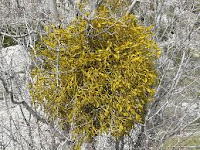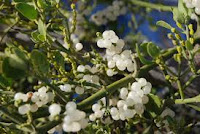 THE OLIVE TREE, OLEA EUROPAEA
THE OLIVE TREE, OLEA EUROPAEAOlive trees are native to Anatolia Turkey, from where they spread to the rest of the Mediterranean region. The olive tree has many legends associated with it and perhaps the most famous is that it came into being when the goddess of wisdom, Athena planted her spear firmly into the ground and it became an olive tree. This was said to have happened in Athena, Athens, the capital city of Greece which is named after the goddess. Greeks will tell you that all Greek olive trees came from cuttings taken from this original tree. In his writings, Homer says that the olive tree created by Athena was 10,000 years old and still growing when he was writing. He also mentions that if anyone destroyed an olive tree, they were sentenced to death, so sacred were they to the ancient Greeks. They appear in paintings from the Minoan period of Greek history dating back to 3,500 BC. On ancient gold coins, Athena is depicted wearing olive leaves on her helmet.

In ancient Olympia in 775 BC, where athletes trained for and competed in the ancient Olympic Games, victors were awarded crowns made from olive branches, and of course the dove and the olive twig is an international symbol of peace. Olive trees are mentioned in the Bible and the dove took an olive twig to Noah after the great flood.
Olive trees have been cultivated for thousands of years, and can live for a thousand years or more, although 500 years is more common. They can grow up to 50 feet high and can have a spread of 30 feet or more. However they are usually pruned to 20 feet so that collection of the fruit is easier. Olives are traditionally harvested by shaking the trees and hitting the branches with long poles so that the olives fall into a net or cloth that has been placed under the tree.
Olives, olive oil and olive leaves are very much a part of the Mediterranean diet, and modern medical research has shown that they are all beneficial to our health. Eating olives or olive oil can help prevent wrinkles, and slow the aging process, can help stop hot flushes in menopausal women, combat the ravages of alcohol, prevent dandruff (rub some oil into a dry scalp), make the hair shiny and healthy, prevent dry skin and acne, stop muscles aching, lower blood pressure and strengthen nails. Olive oil is said to be the reason why Greeks and Italians live to a ripe old age.

Olives and their oil are rich in
Vitamin E,
iron, copper, dietary fibre and the good monounsaturated fats. The leaves are full of
bioflavonoids and have potent antioxidant properties. Traditionally Greeks make a tisane from the leaves to calm frazzled nerves and relieve stress, and give a cup to their city-dwelling relatives when they arrive in their ancestral villages after working in Athens. The tisane can be made from a handful of leaves, and pouring a cupful of water on them and allowing them to steep for 10 to 15 mins, then straining and draining and sweetening with honey. The bark from the tree can also be added to a tisane. The tisane is a diuretic, so you shouldn’t have too many cups of it. Studies have shown that the leaves can help with arrhythmia (irregular heartbeat) and have antimicrobial properties. They may be useful in helping treat HIV/AIDS; they certainly can relieve hypertension, and lower cholesterol levels. They have been used to treat inflammation, diabetes, and infections. The cholesterol lowering effects are believed to come from oleuropein contained in the leaf.

In 1843 a fever, possibly caused by malaria bearing mosquitoes, spread like wildfire through the island of Lesbos (Mytilene) and the decoction made from the leaves of the olive tree were found to be effective in reducing fever. It was reported that this decoction was even better than quinine for reducing malarial fever. This quality had been reported by French and Spanish physicians after the Spanish war between these two countries which lasted from 1808-1813.
I have always been amazed by early people’s imagination, and the leaps they took from tasting a hard, bitter olive picked from the tree, to the deliciousness of olive oil. It’s also amazing that something that tastes so good is so beneficial for our health. In Greece the best olive oil is to be found in villages, and the colour depends on where it comes from. For example, in Northern Greece, around Igoumenitsa, the oil is a golden colour, whereas in the Peloponnesus it is a rich green. The oil from villages is extra virgin, and probably not for sale as it comes from family olive groves and is made for the use of those families. I was lucky enough to have friends who kept me well supplied with oil when I lived in Greece, and it was by far superior to the oil sold in supermarkets. Olive trees produce creamy white flowers, but don’t bear fruit every year, only in alternate years, so to have an annual supply, families plant many olive trees so that they will have a harvest every year.

Black olives from Kalamata are probably the best in the world, as is the oil produced from them. After tasting these any others pale in comparison. However olives are wonderful whether they are black, green, and green stuffed with pimentos or almonds. They can be used on pizzas, in drinks, as mezes with ouzo along with grilled pieces of octopus, or in a
tomato sauce with
capers for the Italian “
putanesca” sauce. Olive oil is wonderful poured over freshly cooked pasta with garlic and basil for a light lunch Italian style, or just dip a piece of bread into the extra virgin oil for a real taste of the Mediterranean.
Olives the olive leaves and olive oil can give you so many health benefits, that you really should invest in the products of the olive tree. Give your taste buds a treat.
The recipe below was given me by a Greek friend, Vassiliki, try it and see what you think.
 BLACK OLIVE SAUCE ARAB STYLE
BLACK OLIVE SAUCE ARAB STYLEIngredients
½ kilo fresh tomatoes, peeled and chopped
1 large
onion, finely sliced
3 cloves
garlic, finely chopped
200 gr black olives, pitted and sliced
1 tbsp capers
dash of Tabasco
olive oil
Method
Heat olive oil in a pan and add the onion. Fry until it is transparent then add the garlic.
Fry over a low heat for 5 mins.
Add all the other ingredients and stir well. It may need a little water, but not much. Bring to the boil then turn the heat down to very low and simmer for 20 mins.
Serve with pasta. If you like, add fresh chopped
coriander leaves as a garnish.
This has Taste and is a Treat.











































